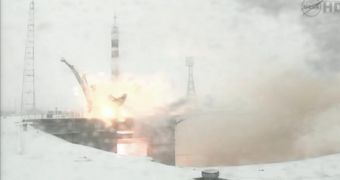The Soyuz TMA-22 spacecraft launched successfully towards the International Space Station on Monday, November 14, aboard a Soyuz delivery system. The manned capsule is now flying two Russians and an American to the space lab, where they are scheduled to arrive on Wednesday.
The launch effort was very complex and tense, for a number of reasons. The most important is that a rocket similar to the one used yesterday failed during launch on August 24, destroying the Progress 44 unmanned spacecraft.
Since then, the Russian Federal Space Agency (RosCosmos) managed to launch the Progress 45 resupply capsule, which was also bound for the ISS. The success of the mission testified that the Progress 44 failure was indeed a localized incident, and not a generalized fault of the delivery system.
The second thing that could have posed a problem to Russian mission controllers at the Baikonur Cosmodrome, in Kazakhstan, was the weather. There was a lot of snow at and around the launch pad, and officials were considering postponing the mission until the weather was more suitable.
However, on the day of the launch, it was determined that wind speeds were sufficiently low to allow for a safe launch, so the necessary go-ahead was given. The Soyuz-FG rocket successfully delivered its payload to orbit in less than 10 minute.
The Expedition 29 crew is expected to dock to the orbital outpost on Wednesday, November 16. The maneuver is scheduled to conclude at 0530 GMT. The spacecraft will dock to the ISS' Russian-built Poisk module, Space reports.
Launch from Baikonur occurred at 10:14 am Baikonour time (0414 GMT) today. The Soyuz TMA-22 crew was made up of RosCosmos' Anton Shkaplerov and Anatoly Ivanishin, as well as NASA astronaut Dan Burbank.
Waiting for them in orbit are NASA astronaut and Expedition 29 Commander Mike Fossum, as well as Japan Aerospace Exploration Agency (JAXA) astronaut Satoshi Furukawa and Russian cosmonaut Sergei Volkov, who are both flight engineers.
However, the joint crew will remain together for less than a week. The three astronauts already in space are scheduled to depart the ISS on November 21, as they have been in space since June. Their departure will mark the end of Expedition 29, and the beginning of Expedition 30.
Fossum will hand over command of the ISS to Burbank shortly before leaving the ISS. The other half of Expedition 30 is currently scheduled to arrive in space following a December 21 launch, aboard the Soyuz TMA-03M spacecraft.
The second leg of the Expedition will be made up of RosCosmos' Oleg Kononenko, European Space Agency (ESA) astronaut André Kuipers and NASA astronaut Donald Pettit.

 14 DAY TRIAL //
14 DAY TRIAL //